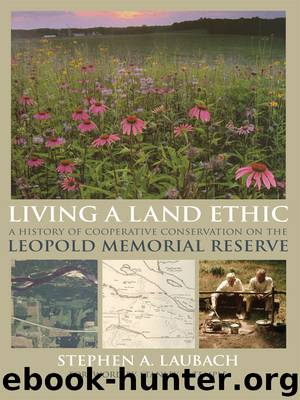Living a Land Ethic by Stephen A. Laubach

Author:Stephen A. Laubach [A. Laubach, Stephen]
Language: eng
Format: epub
Publisher: University of Wisconsin Press
New Directions for the Reserve’s Nonprofit Organizations
Beyond the changes brought on by the establishment of the Bradley Study Center, an important realignment in the nonprofit oversight of the reserve took place in the early 1980s. To promote more clearly its affiliation with Aldo Leopold, the L. R. Head Foundation changed its name in 1982 to the Sand County Foundation. Because of Leopold’s well-known book of essays, A Sand County Almanac, the new title made the foundation more recognizable as one devoted to conservation. It also presaged their shift early in the next decade toward a national and global reach in ecological land stewardship.
In the early 1980s, the Leopold family trust also reached a crossroads as it decided what to do with the shack property. Some family members wanted to donate the land to Aldo Leopold’s home institution, the University of Wisconsin–Madison, which would have opened it up to more research and a greater number of visitors. Others wanted to keep the site in the family and thus more private. According to Nina Bradley, “Starker was at the helm of this [decision], and his idea was to give the shack and the area to the University of Wisconsin for research, or however they could use it. Then three or four of the nieces and nephews got together and said ‘No, no thank you, we don’t want to do that.’ So at that point they decided on establishing a foundation.”14
Bradley’s daughter Trish Stevenson described how she and her cousin Susan Freeman approached Starker about their feelings on keeping the land in the family: “We took Starker out in the prairie and we were really nervous and we said, ‘We really don’t want our inheritance to go to the university.’ And he didn’t know that there were younger family members that cared that much.” Leopold’s daughter Estella has also testified to the fact that younger family members were instrumental in pushing the family elders to consider forming a family foundation: “I think the whole idea there was instigated by these young people, that we ought to have our own family group running it as a foundation.”15 Those who advocated keeping the land in private hands felt strongly that the shack still served an important purpose for the family, and this argument convinced Starker and his siblings not to donate it, a decision that profoundly shaped the management of the land and public visitation to the shack. Because the Leopolds kept the land in family hands and still used it for personal visits, they continued their policy of restricted public access to land that had by this time become quite famous.
The five children of Aldo and Estella Leopold thus decided in December 1982 to establish a separate nonprofit organization, the Aldo Leopold Shack Foundation (ALSF). Its landholdings were restricted to the 200 acres of the reserve owned by the Leopold family. Many of the objectives of the ALSF complemented those stipulated in the bylaws of both the Head Foundation and the Leopold Memorial Reserve
Download
This site does not store any files on its server. We only index and link to content provided by other sites. Please contact the content providers to delete copyright contents if any and email us, we'll remove relevant links or contents immediately.
| Africa | Americas |
| Arctic & Antarctica | Asia |
| Australia & Oceania | Europe |
| Middle East | Russia |
| United States | World |
| Ancient Civilizations | Military |
| Historical Study & Educational Resources |
Cat's cradle by Kurt Vonnegut(14757)
Pimp by Iceberg Slim(13777)
Underground: A Human History of the Worlds Beneath Our Feet by Will Hunt(11836)
4 3 2 1: A Novel by Paul Auster(11788)
The Radium Girls by Kate Moore(11619)
Wiseguy by Nicholas Pileggi(5315)
American History Stories, Volume III (Yesterday's Classics) by Pratt Mara L(5133)
Perfect Rhythm by Jae(5070)
The Fire Next Time by James Baldwin(5016)
Paper Towns by Green John(4790)
Pale Blue Dot by Carl Sagan(4613)
A Higher Loyalty: Truth, Lies, and Leadership by James Comey(4550)
The Mayflower and the Pilgrims' New World by Nathaniel Philbrick(4277)
The Doomsday Machine by Daniel Ellsberg(4244)
Killers of the Flower Moon: The Osage Murders and the Birth of the FBI by David Grann(4188)
The Sympathizer by Viet Thanh Nguyen(4093)
Too Much and Not the Mood by Durga Chew-Bose(4089)
The Borden Murders by Sarah Miller(4013)
Sticky Fingers by Joe Hagan(3911)
